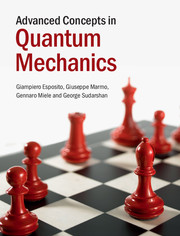Book contents
- Frontmatter
- Contents
- Preface
- 1 Introduction: the need for a quantum theory
- 2 Experimental foundations of quantum theory
- 3 Waves and particles
- 4 Schrödinger picture, Heisenberg picture and probabilistic aspects
- 5 Integrating the equations of motion
- 6 Elementary applications: one-dimensional problems
- 7 Elementary applications: multi-dimensional problems
- 8 Coherent states and related formalism
- 9 Introduction to spin
- 10 Symmetries in quantum mechanics
- 11 Approximation methods
- 11A Perturbation theory
- 11B Jeffreys–Wentzel–Kramers–Brillouin method
- 11C Scattering theory
- 12 Modern pictures of quantum mechanics
- 13 Formulations of quantum mechanics and their physical implications
- 14 Exam problems
- 15 Definitions of geometric concepts
- References
- Index
11C - Scattering theory
Published online by Cambridge University Press: 05 November 2014
- Frontmatter
- Contents
- Preface
- 1 Introduction: the need for a quantum theory
- 2 Experimental foundations of quantum theory
- 3 Waves and particles
- 4 Schrödinger picture, Heisenberg picture and probabilistic aspects
- 5 Integrating the equations of motion
- 6 Elementary applications: one-dimensional problems
- 7 Elementary applications: multi-dimensional problems
- 8 Coherent states and related formalism
- 9 Introduction to spin
- 10 Symmetries in quantum mechanics
- 11 Approximation methods
- 11A Perturbation theory
- 11B Jeffreys–Wentzel–Kramers–Brillouin method
- 11C Scattering theory
- 12 Modern pictures of quantum mechanics
- 13 Formulations of quantum mechanics and their physical implications
- 14 Exam problems
- 15 Definitions of geometric concepts
- References
- Index
Summary
Aims and problems of quantum scattering theory
Scattering theory is the branch of physics concerned with interacting systems on a scale of time and/or distance that is large compared with the scale of the interaction itself, and it provides the most powerful tool for studying the microscopic nature of the world. In quantum mechanics, a typical scattering process involves a beam of particles prepared with a given energy and with a more or less defined linear momentum. One then studies either the collision with a similar wave packet, or the collision of the given wave packet against a fixed target. In particular, for a two-body elastic scattering problem with conservative forces, we work in the centre of mass frame, hence reducing the original problem to the analysis of a particle in an external field of forces. Indeed, in Section 7.2 we already used such a technique in the investigation of the hydrogen atom. The crucial difference with respect to Section 7.2 is that, in scattering problems, the continuous spectrum and its perturbations are studied, whereas the Balmer formula has to do with bound states. In the following section we outline the basic aspects of what is called time-dependent scattering.
Time-dependent scattering
The physical situation we would like to study is as follows: a beam of particles is prepared in a state that is approximately free and allowed to evolve towards the scatterer. After the collision we detect the scattered beam far away from the interaction region.
- Type
- Chapter
- Information
- Advanced Concepts in Quantum Mechanics , pp. 282 - 300Publisher: Cambridge University PressPrint publication year: 2014



